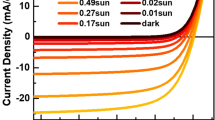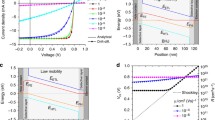Abstract
The standard drift–diffusion model (DDM) was used for calculation of organic solar cells’ (OSCs) J–V characteristics under different assumption sets. One analytical (DDMA) and two numerical (DDMN1, DDMN2) solutions were obtained. In the DDMA, a Beer–Lambert absorption profile, a constant electric field and a monomolecular charge carrier recombination were used. Interference effects as well as space charge effects were included in numerical models. The monomolecular recombination mechanism was applied in the DDMN1, while the Langevin bimolecular recombination was assumed in the DDMN2. Simulated and measured J–V curves are compared for ITO/PEDOT:PSS/P3HT:PCBM/Al solar cells in the dark regime and under illumination. Experimentally obtained dark J–V curves are best reproduced by the DDMA, while the DDMN2 gives the best prediction for J–V characteristics under illumination. Additionally, it was shown that the recombination of holes and electrons can be neglected in the dark mode and a simple Shockley-like J(V) expression was derived from the DDMA. From our analysis, it can be concluded that in the dark regime the electric field in OSCs is homogeneous and electrons and holes recombine monomolecularly, although to a negligible extent. When the OSC is illuminated, the space charge effects become significant in the active layer, as well as the charge carrier recombination, which gains the bimolecular Langevine character.


Similar content being viewed by others
References
Bagher, A.M.: Comparison of organic solar cells and inorganic solar cells. Int. J. Renew. Sustain. Energy 3(3), 53–58 (2014)
Chin, V.J., Salam, Z., Ishaque, K.: Cell modelling and model parameters estimation techniques for photovoltaic simulator application: a review. Appl. Energy 154, 500–519 (2015)
Cowan, S.R., Roy, A., Heeger, A.J.: Recombination in polymer-fullerene bulk heterojunction solar cells. Phys. Rev. B (2010). https://doi.org/10.1103/PhysRevB.82.245207
Cowan, S.R., Banerji, N., Leong, W.L., Heeger, A.J.: Charge formation, recombination, and sweep-out dynamics in organic solar cells. Adv. Funct. Mater. 22, 1116–1128 (2012)
Haldi, A., Sharma, A., Potscavage, W.J., Kippelen, B.: Equivalent circuit model for organic single-layer diodes. J. Appl. Phys. (2008). https://doi.org/10.1063/1.2980324
Hawks, S.A., Li, G., Yang, Y., Street, R.A.: Band tail recombination in polymer: fullerene organic solar cells. J. Appl. Phys. (2014). https://doi.org/10.1063/1.4892869
Jelić Ž.: Modeling of solar cell with active layer based on conjugated polymer. Master thesis, School of Electrical Engineering, University of Belgrade (2013)
Jelić, Ž., Petrović, J., Matavulj, P., Melancon, J., Sharma, A., Zellhofer, C., Živanović, S.: Modeling of the polymer solar cell with P3HT:PCBM active layer. Phys. Scr. (2014). https://doi.org/10.1088/0031-8949/2014/T162/014035
Koster, L.J.A., Smits, E.C.P., Mihailetchi, V.D., Blom, P.W.M.: Device model for the operation of polymer/fullerene bulk heterojunction solar cells. Phys. Rev. B (2005a). https://doi.org/10.1103/PhysRevB.72.085205
Koster, L.J., Mihailetchi, V.D., Xie, H., Blom, P.W.: Origin of the light intensity dependence of the short-circuit current of polymer/fullerene solar cells. Appl. Phys. Lett. (2005b). https://doi.org/10.1063/1.2130396
Kumar, P., Jain, S.C., Kumar, V., Chand, S., Tandon, R.P.: A model for the J–V characteristics of P3HT:PCBM solar cells. J. Appl. Phys. (2009). https://doi.org/10.1063/1.3129320
Laquai, F., Andrienko, D., Mauer, R., Blom, P.W.M.: Charge carrier transport and photogeneration in P3HT:PCBM Photovoltaic Blends. Macromol. Rapid Commun. 36, 1001–1025 (2015)
Li, G., Liu, L., Wei, F., Xia, S., Qian, X.: Recent progress in modeling, simulation, and optimization of polymer solar cells. IEEE J. Photovolt. 2(3), 320–340 (2012)
Mazhari, B.: An improved solar cell circuit model for organic solar cells. Sol. Energy Mater. Sol. Cells 90, 1021–1033 (2006)
Mihailetchi, V.D., Xie, H., de Boer, B.L., Koster, J.A., Paul Blom, W.M.: Charge transport and photocurrent generation in poly(3-hexylthiophene): methanofullerene bulk-heterojunction solar cells. Adv. Funct. Mater. 16, 699–708 (2006)
Müller, A., Jovanov, V., Wagner, V.: Analytical model (CELIC) for describing organic and inorganic solar cells based on drift-diffusion calculations. Appl. Phys. Lett. (2017). https://doi.org/10.1063/1.4993778
Pozo, G.D., Romero, B., Arredondo, B.: Extraction of circuital parameters of organic solar cells using the exact solution based on Lambert W- function. Proc. SPIE 8435, 84351Z-1 (2012)
Ren, X., Wang, Z., Sha, W.E.I., Choy, W.C.H.: Exploring the way to approach the efficiency limit of perovskite solar cells by drift–diffusion model. ACS Photon. 4(4), 934–942 (2017)
Scharber, M.C., Sariciftci, N.S.: Efficiency of bulk-heterojunction organic solar cells. Prog. Polym. Sci. 38, 1929–1940 (2013)
Servaites, J.D., Yeganeh, S., Marks, T.J., Ratner, M.A.: Efficiency enhancement in organic photovoltaic cells: consequences of optimizing series resistance. Adv. Funct. Mater. 20, 97–104 (2010)
Servaites, J.D., Ratner, M.A., Marks, T.J.: Organic solar cells: a new look at traditional models. Energy Environ. Sci. 4, 4410–4422 (2011)
Sha, W.E.I., Ren, X., Chen, L., Choy, W.C.H.: The efficiency limit of CH3NH3PbI3 perovskite solar cells. Appl. Phys. Lett. (2015). https://doi.org/10.1063/1.4922150
Sha, W.E.I., Zhang, H., Wang, Z.S., Zhu, H.L., Ren, X., Lin, F., Jen, A.K.-Y., Choy, W.C.H.: Quantifying efficiency loss of perovskite solar cells by a modified detailed balance model. Adv. Energy Mater. (2018). https://doi.org/10.1002/aenm.201701586
Shockley, W.: The theory of p–n junctions in semiconductors and p–n junction transistors. Bell Syst. Tech. J. 28(3), 435–489 (1949)
Sievers, D.W., Shrotriya, V., Yang, Y.: Modeling optical effects and thickness dependent current in polymer bulk-heterojunction solar cells. J. Appl. Phys. (2006). https://doi.org/10.1063/1.2388854
Tress, W., Leo, K., Riede, M.: Optimum mobility, contact properties, and open-circuit voltage of organic solar cells: a drift-diffusion simulation study. Phys. Rev. (2012). https://doi.org/10.1103/PhysRevB.85.155201
Yoo, S., Domercq, B., Kippelen, B.: Intensity-dependent equivalent circuit parameters of organic solar cells based on pentacene and C60. J. Appl. Phys. (2005). https://doi.org/10.1063/1.1895473
Acknowledgements
This work was supported by the Serbian Ministry of Education, Science and Technological Development under contract No. 171011. We thank Grant Ledet for proofreading the article.
Author information
Authors and Affiliations
Corresponding author
Additional information
Publisher's Note
Springer Nature remains neutral with regard to jurisdictional claims in published maps and institutional affiliations.
This article is part of the Topical Collection on Advanced Photonics Meets Machine Learning.
Guest edited by Goran Gligoric, Jelena Radovanovic and Aleksandra Maluckov.
Rights and permissions
About this article
Cite this article
Stanojević, M., Gojanović, J., Matavulj, P. et al. Organic solar cell physics analyzed by Shockley diode equation. Opt Quant Electron 52, 345 (2020). https://doi.org/10.1007/s11082-020-02459-6
Received:
Accepted:
Published:
DOI: https://doi.org/10.1007/s11082-020-02459-6




